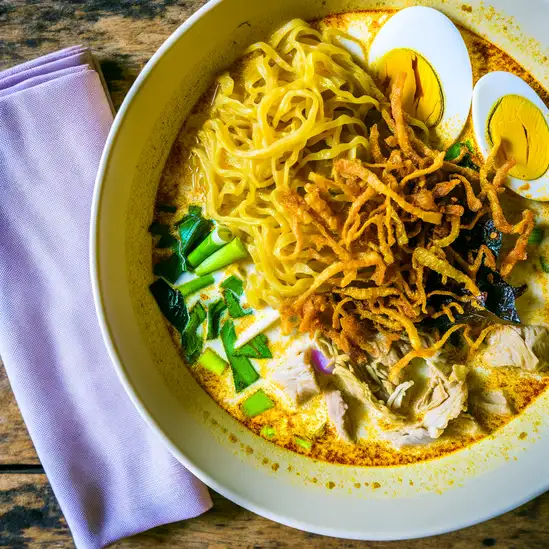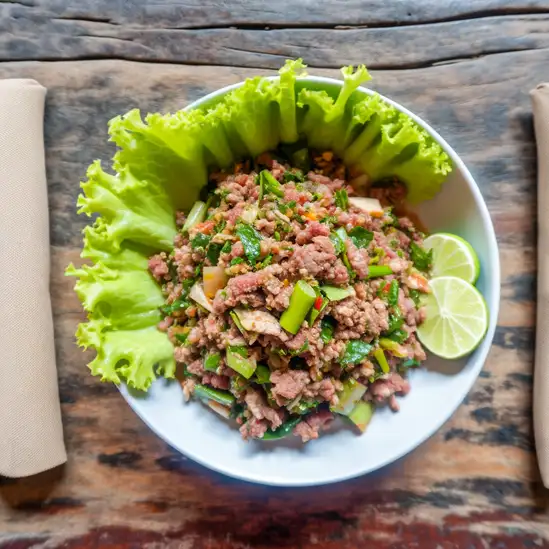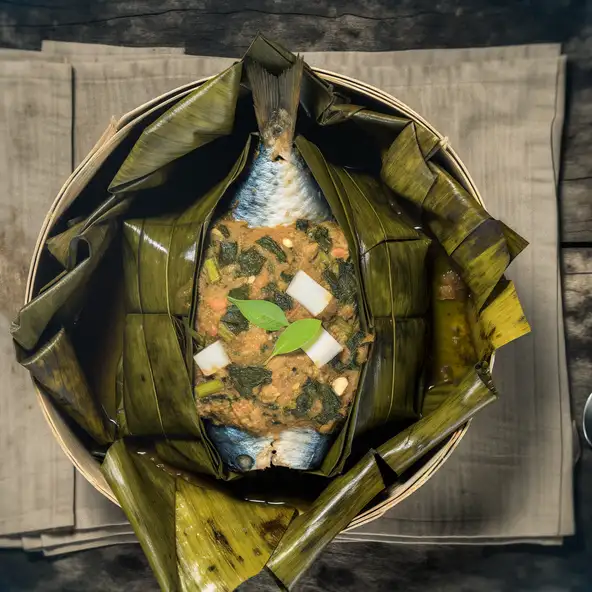



If you find yourself wandering through Muang Pakxé,you’ll immediately notice a gentle rhythm to the place—a laid-back pulse that feels both alive and unhurried. The Mekong River lazily curves alongside the town,its waters shimmering under the warm Lao sun,while the scent of grilled street food mingles with the earthy aroma of fresh herbs from the markets. It’s a city where motorbikes hum softly past colonial-era buildings,and monks in saffron robes weave through the streets with quiet purpose. Pakxé’s charm lies in its blend of cultures and landscapes. You can sip strong,sweet Lao coffee at a riverside café,watching fishermen cast their nets,or dive into a bowl of spicy papaya salad that tingles your tongue with just the right kick. The local markets buzz with chatter and laughter,stalls bursting with vibrant textiles,fresh tropical fruits,and fragrant spices. There’s a warmth in the people here—a genuine friendliness that invites you to slow down and soak in the moment. What really sets Pakxé apart is its gateway feel. It’s the perfect launchpad to explore the surrounding Bolaven Plateau,with its cascading waterfalls and rolling tea plantations,or to catch a boat to the 4,000 Islands. But even if you never leave the town itself,Pakxé offers a rich tapestry of sights,sounds,and flavors that linger long after you’ve gone. It’s a place that feels like a quiet conversation with Laos itself—inviting,sincere,and full of stories waiting to be discovered.
The information on this page is currently being reviewed by Tripkliq and should be used as a guide only
Eng word: Hello
Eng pronunciation: sa-bai-dee
Local language: ສະບາຍດີ
Eng word: Goodbye
Eng pronunciation: la-gon
Local language: ລາກ່ອນ
Eng word: Thank you
Eng pronunciation: khawp-jai
Local language: ຂອບໃຈ
Eng word: How much
Eng pronunciation: thao-dai
Local language: ເທົ່າໃດ
Eng word: Toilet
Eng pronunciation: hong-nam
Local language: ຫ້ອງນ້ຳ
Eng word: Help me
Eng pronunciation: suay-khoi-nae
Local language: ຊ່ວຍຂ້ອຍແນ່
Eng word: Yes
Eng pronunciation: maen-laew
Local language: ແມ່ນແລ້ວ
Eng word: No
Eng pronunciation: bo
Local language: ບໍ່
Eng word: Excuse me
Eng pronunciation: khor-thot
Local language: ຂໍໂທດ
Pakxé, meaning 'Mouth of the River Se', was founded in 1905 by the French during their colonial rule in Laos. It served as an administrative and trading hub due to its strategic location at the confluence of the Mekong and Xe Don rivers.
The Champasak Royal Palace, now the Champasak Historical Heritage Museum, was built in 1954 for Prince Boun Oum. It showcases a blend of French colonial and traditional Lao architectural styles and houses artifacts that reflect the region's rich history.
Pakxé is known as the gateway to the Bolaven Plateau, a region famous for its cool climate, stunning waterfalls, and coffee plantations. The plateau has been a vital part of the region's economy and culture for centuries.
Wat Luang, the largest and most important temple in Pakxé, was built in 1935. It serves as a center for Buddhist learning and ceremonies, and its serene atmosphere attracts both locals and tourists.
Pakxé retains many remnants of its French colonial past, including architecture and urban planning. The city's layout and some of its older buildings reflect the influence of French design.
Completed in 2002, the Pakxé Bridge spans the Mekong River and connects the city to the Bolaven Plateau. It is a symbol of modern development and plays a crucial role in the region's transportation network.
Pakxé is home to a diverse population, including ethnic Lao, Chinese, and Vietnamese communities. This cultural diversity is reflected in the city's cuisine, markets, and festivals.
The Mekong River has been central to Pakxé's history, serving as a vital trade route and source of livelihood for the local population. It continues to be a focal point for tourism and commerce.
Pakxé is a major hub for coffee production in Laos, with the Bolaven Plateau producing some of the finest coffee in the world. The coffee industry has its roots in the French colonial era and remains a key economic driver.
In Muang Pakxé, the most common Power Adaptor is Type C, Type E, Type F.







A noodle soup made with egg noodles, coconut milk, and a variety of meats, garnished with fresh herbs and lime.

A traditional Lao salad made with minced meat (often chicken, beef, or fish), mixed with herbs, lime juice, and roasted rice powder, served with fresh vegetables.

A spicy green papaya salad that combines shredded unripe papaya, tomatoes, lime, fish sauce, and chili, often served with sticky rice.

Sticky rice, a staple in Lao cuisine, often served alongside various dishes and enjoyed with hands.

Steamed fish wrapped in banana leaves, seasoned with herbs and spices, providing a fragrant and flavorful dish.

A spicy Lao sausage made from minced pork, herbs, and spices, often grilled and served with fresh vegetables.

A popular street food influenced by French colonialism, filled with various ingredients like grilled meats, vegetables, and sauces.
If you ever find yourself wandering through Luang Prabang,you’ll immediately notice a gentle calm that seems to wrap around the town like a soft,warm blanket. It’s the kind of place where mornings start with the quiet shuffle of monks in saffron robes collecting alms,their presence weaving a peaceful rhythm into the day. The air carries a mix of fragrant incense,fresh river breeze,and the subtle sweetness of grilled street food wafting from the night market. Walking along the Mekong River at sunset,the sky blushes in shades of pink and gold,reflecting off the water and making everything feel a little more magical.
The city’s charm lies in its blend of old and new — colonial French architecture stands side by side with ancient Buddhist temples,their intricate carvings telling stories that have lasted centuries. You can lose yourself in narrow streets lined with wooden houses,each corner revealing a quiet café or a bustling market stall selling sticky rice wrapped in banana leaves or freshly brewed Lao coffee that’s rich and earthy. The locals greet you with genuine smiles,and there’s a softness in their hospitality that makes you feel like you’re more than just a visitor.
What really makes Luang Prabang unforgettable is how it invites you to slow down and savor the moment. Whether you’re watching the monks’ morning procession,exploring hidden waterfalls nearby,or simply sitting by the river with a cold Beerlao in hand,the city encourages a kind of mindful joy that stays with you long after you leave.
If you ever find yourself wandering through Southeast Asia,Vientiane feels like a gentle breath of fresh air—a city that moves at its own unhurried pace,inviting you to slow down and soak it all in. The moment you step onto its quiet streets,you’re greeted by the soft hum of motorbikes weaving past golden temples and the distant clang of monks’ bells. There’s a calmness here that’s almost tangible,like the city itself is taking a deep,peaceful breath.
Walking along the Mekong River at sunset is pure magic. The sky blushes pink and orange,and the river carries the scent of grilled street food—sticky rice wrapped in banana leaves,smoky and sweet,mingling with the earthy aroma of fresh herbs. Vendors call out softly,offering you a taste of Laos’ simple but rich flavors. It’s a place where you can sit on a wooden bench,sip strong Lao coffee,and watch families and friends gather for evening strolls,their laughter floating on the warm breeze.
What makes Vientiane truly special is its blend of old and new. Ancient Buddhist stupas stand proudly beside quirky cafés and colorful markets,while the locals’ genuine warmth makes you feel like you’re part of a close-knit community rather than a tourist passing through. It’s a city that doesn’t rush to impress but quietly charms you with its authenticity and heart. Trust me,Vientiane stays with you long after you leave.
Siem Reap feels like stepping into a living storybook where ancient history and vibrant local life dance together effortlessly. The moment you arrive,there’s this warm,inviting energy—friendly smiles from tuk-tuk drivers,the hum of motorbikes weaving through bustling markets,and the scent of lemongrass and grilled street food mingling in the air. It’s a place where the past isn’t just preserved behind glass but pulses through every corner,especially when you wander the awe-inspiring temples of Angkor at sunrise,watching the soft golden light spill over intricate stone carvings and jungle vines.
Beyond the temples,the town itself is a lively mosaic of colorful markets,cozy cafés,and lively night bazaars. You’ll hear the chatter of locals bargaining over fresh produce,the clinking of glasses in open-air bars,and the occasional traditional Khmer music drifting from a nearby restaurant. The food scene is a delicious adventure—imagine biting into a crispy,fragrant fish amok or savoring sweet mango sticky rice while sitting under a canopy of twinkling lights.
What really makes Siem Reap special is its balance of old and new,calm and excitement. You can spend your mornings exploring centuries-old ruins and your afternoons relaxing with a foot massage or cycling through rice paddies. It’s a place that invites you to slow down,soak in the stories,and feel connected—not just to Cambodia’s rich heritage but to the warm-hearted people who call it home.
Bangkok is one of those cities that grabs you the moment you step out into its bustling streets. There’s this electric energy in the air—a mix of honking tuk-tuks,sizzling street food stalls,and the chatter of locals weaving through markets. The city feels alive,like it’s constantly moving and breathing,yet somehow it balances this chaos with moments of serene beauty,like the golden spires of temples catching the afternoon sun or quiet canals reflecting the sky.
Walking through Bangkok,you’ll be hit by a whirlwind of scents:fragrant jasmine from flower vendors,the sharp tang of lemongrass and chili from street carts,and the sweet aroma of mango sticky rice tempting you at every corner. The colors are just as vivid—neon signs flicker alongside traditional wooden shophouses,and monks in saffron robes glide past modern skyscrapers. It’s a city where old and new dance together effortlessly.
What really makes Bangkok special is its warmth and openness. The people here have a genuine kindness that shines through,whether you’re bargaining at Chatuchak Market or sharing a laugh over a bowl of spicy boat noodles. The culture is rich and layered,from the intricate rituals at Wat Pho to the lively festivals that light up the streets. Visiting Bangkok feels like stepping into a story that’s still unfolding,full of surprises and moments that stay with you long after you leave.
Ho Chi Minh City pulses with an energy that’s impossible to ignore—like the city itself is alive,breathing through its bustling streets and vibrant markets. The moment you step out,you’re greeted by a symphony of honking scooters weaving through the maze of narrow alleys,the sizzling sound of street food grilling on every corner,and the rich aroma of fresh herbs mingling with strong Vietnamese coffee. It’s chaotic but in the best way,a place where tradition and modernity collide in colorful,unexpected ways.
Walking through District 1,you’ll catch glimpses of French colonial architecture standing proudly beside sleek skyscrapers,while locals sip iced cà phê sữa đá at tiny plastic stools,chatting animatedly. The city’s character is raw and real—no polished tourist traps here,just genuine moments and warm smiles. At night,the streets transform as neon signs flicker on,and the scent of grilled seafood and sweet bánh mì fills the air,inviting you to taste the city’s soul.
What makes Ho Chi Minh City truly unforgettable is its resilience and spirit. It’s a place where history whispers from the War Remnants Museum and the Cu Chi Tunnels,yet life moves forward with a youthful,entrepreneurial buzz. Whether you’re savoring a bowl of pho at dawn or exploring vibrant art galleries and rooftop bars,the city wraps you in its embrace,making you feel like you’re part of its ongoing story.
Phnom Penh feels like a city caught between moments—where the past and present hum together in a lively,unexpected rhythm. Walking along the riverfront at sunset,you’ll catch the warm glow of golden light bouncing off the Tonle Sap and Mekong rivers,while the chatter of locals and the distant honk of tuk-tuks create a soundtrack that’s both chaotic and comforting. The air carries a mix of aromas:sizzling street food,fresh herbs,and the faint scent of incense from nearby temples. It’s a place where history isn’t just in museums but etched into the streets and faces of the people.
The city’s character is raw and real,with grand colonial buildings standing shoulder to shoulder with bustling markets and sleek new cafes. You can lose yourself in the maze of Russian Market stalls,where vendors call out in a friendly,rapid-fire Khmer,offering everything from handwoven scarves to spicy grilled meats. At night,the city pulses with energy—bars and eateries spill onto sidewalks,and the smell of lemongrass and chili fills the air as you try dishes like fish amok or fresh spring rolls.
What makes Phnom Penh truly unforgettable is its resilience and warmth. Despite its turbulent history,the city welcomes you with open arms and a genuine smile. It’s a place where every corner tells a story,and every meal,every conversation,feels like an invitation to understand a culture that’s vibrant,complex,and deeply human.
Some ATMs may be tampered with to steal card information, especially in less secure or isolated locations.
Tourists may be charged excessive fees for boat rides on the Mekong River or to nearby islands.
Some money exchange services may use incorrect rates or give counterfeit bills to tourists unfamiliar with the local currency.
Scammers may approach tourists claiming to collect donations for local schools or orphanages, but the money is pocketed instead.
Individuals posing as tour guides may offer overpriced or fake tours, providing little value or skipping promised attractions.
Rental shops may claim damages to motorbikes upon return, even if the damage was pre-existing, to charge extra fees.
Vendors in tourist-heavy areas may charge significantly higher prices for souvenirs compared to local markets.
Crowded areas like markets or festivals can be hotspots for pickpockets targeting distracted tourists.
Some restaurants may have separate menus for locals and tourists, with higher prices for the latter.
Tuk-tuk drivers may quote inflated prices for short rides, especially if tourists are unfamiliar with local rates.
The use, possession, and trafficking of drugs are strictly illegal in Laos, including Muang Pakxé. The penalties for drug-related offenses are severe and can include long prison sentences, heavy fines, or even the death penalty for serious cases. Tourists should avoid any involvement with drugs and be cautious about their belongings to ensure they are not unknowingly carrying prohibited substances.
In Muang Pakxé, Laos, smoking is generally allowed in public spaces, but there are restrictions in certain areas such as government buildings, hospitals, schools, and public transportation. Tourists should be mindful of 'No Smoking' signs and avoid smoking in places where it may disturb others. Smoking indoors in restaurants and hotels may also be restricted depending on the establishment's policy.
Vaping is not explicitly regulated in Laos, including Muang Pakxé, but it is less common and may attract attention. Tourists should exercise caution and avoid vaping in public spaces or areas where smoking is prohibited. It is advisable to check with local authorities or establishments for specific rules regarding vaping.
What are other people saying about Muang Pakxé?
Recent Social posts about Muang Pakxé
There is nothing to show you for now.